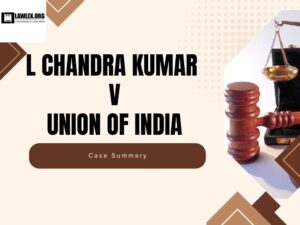Case Name– L. Chandra Kumar vs. Union of India (UOI) and Ors.
Citation– A.I.R 1997 SC 1125
Court– The Supreme Court of India
Bench of Judges– A.M. Ahmadi CJI, M.M. Punchhi, K. Ramaswamy, S.P. Bharucha, S. Saghir Ahmad, K. Venkataswami and K.T. Thomas, JJ.
Parties– Petitioner– L. Chandra Kumar
Respondent– Union of India
Background of the case–
Part XIVA of the Constitution was inserted through Section 46 of the Constitution Amendment (42nd Amendment) Act, 1976. It led to the insertion of two articles dealing with Tribunals in India- Article 323A and Article 323B. Furthermore, the legislature also enacted the Administrative Tribunals Act, 1985, to give effect to the law under Articles 323A and 323B. The Act also primarily aimed to reduce the burden of courts, address policy issues for certain government-related matters and also carry out speedy disposal of disputes.
However, these provisions curtailed the power of all courts in India, except the power under Article 136 of the Supreme Court of India to issue Special Leave Petitions. The power of the High Court and the Supreme Court regarding judicial review and superintendence powers was in dispute.
Issues of the case-
- Whether the Sub-clause (d) of Clause (2) of Article 323A or Sub-clause (d) of Clause (3) of Article 323B of the Constitution, totally excludes the jurisdiction of ‘all courts’, except that of the Supreme Court under Article 136, in respect of disputes referred section itself?
- Whether the Tribunals, constituted either under Article 323A or under Article 323B of the Constitution, possess the competence to test the constitutional validity of a statutory provision/rule?
- Whether these Tribunals, as they are functioning at present, can be said to be effective substitutes for the High Courts in discharging the power of judicial review? If not, what changes are required to make them conform to their founding objectives?
Arguments-
Petitioner– The petitioner argued that the Supreme Court and the High Court are the sole repositories of the power of judicial review. While the tribunals can have the power of judicial review on matters of an administrative nature, only constitutional courts can possess the power of judicial review on legislative action.
Furthermore, the petitioner gave a set of reasons explaining why the High Courts can never be equated with the Tribunals-
- High Courts are Courts of Record under Article 215 and also have the power to issue Certificates of Appeal under Article 132 and 133 of the Constitution in times when they feel a decision of the Supreme Court is required, which is not the case for Tribunals.
- The qualifications needed for being a High Court judge, as well as the constitutional safeguards provided to them, are not at all comparable to those of the Tribunal composition.
- The jurisdiction of the High Court is protected under the Constitution, unlike the Tribunals, whose power can be taken away by mere repeal of the parent act.
- The expenditure of the High Court is charged upon the Consolidated Fund of India, whereas the Tribunal is dependent on the appropriate government for grants and aids.
- Under Article 226 and Article 227 of the Constitution, every High Court has the power to issue writs to all authorities of the State which function within its territorial jurisdiction. In such a situation, no authority or Tribunal located within the territorial jurisdiction of a High Court can disregard the law declared by it. The impugned constitutional provisions seek to divest the High Courts of their power of superintendence over all Tribunals and Courts situated within their territorial jurisdiction, and violate the basic structure of the Indian Constitution.
Respondent– The state argued by quoting the decision in Sampath Kumar v. Union of India[1], where the court held that though judicial review is an essential part of the basic structure doctrine, vesting the power in another institutional mechanism after removing it from the High Court does not amount to a violation of the constitution, as long as the institutional mechanism is effective and a real substitute for the High Court.
The state also mentioned M.B. Majumdar v. Union of India.[2], whereby it was held that tribunals are effective substitutes for High Courts in adjudicating service matters.
The Judgement-
The Hon’ble Supreme Court held that Clause 2(d) of Article 323A and Clause 3(d) of Article 323B, to the extent they exclude the jurisdiction of the High Courts and the Supreme Court under Articles 226/227 and 32 of the Constitution, are unconstitutional.
The jurisdiction conferred upon the High Courts under Articles 226/227 and upon the Supreme Court under Article 32 of the Constitution is a part of the inviolable basic structure of our Constitution.
The court further held that Tribunals may perform a supplemental role in discharging the powers conferred by Articles 226/227 and 32 of the Constitution.
The court also held that all the decisions of the Tribunals will be subject to scrutiny before a Division Bench of the High Court within whose jurisdiction the concerned Tribunal falls.
Importance and Impact-
The judgment reaffirmed the supremacy of the judiciary and preserved the basic structure doctrine. It ensured that no law or tribunal can act as the final authority over the citizens’ rights. Nevertheless, it created a balance between administrative efficiency via tribunals and protection of fundamental rights via courts.
Today, Tribunal orders are appealable before High Courts, and the checks and balances system between the legislature and the judiciary has been further strengthened.
Tribunals can assist justice, not replace it, and Judicial Review is the soul of our Constitution.
[1] 1987 AIR 386; 1987 SCR (1) 435; 1987 SCC (1) 124
[2] (1990) 4 SCC 501; AIR 1990 SC 2263; (1990) 3 SCR 946


